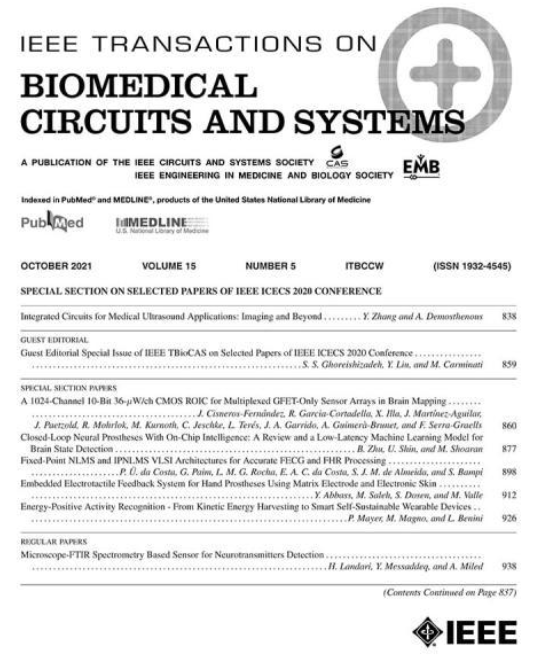一种产生时间适应的脊柱内微刺激模式的混合信号VLSI系统。
IF 4.9
2区 医学
Q2 ENGINEERING, BIOMEDICAL
IEEE Transactions on Biomedical Circuits and Systems
Pub Date : 1900-01-01
DOI:10.1109/TBCAS.2015.2501419
引用次数: 0
摘要
神经通路可以通过电刺激人工激活。对于脊髓损伤的个体,使用125 μ a左右的电流进行椎管内微刺激,可以产生适合于恢复行走的下肢肌肉收缩和关节扭矩。本研究展示了一种集成电路,实现了一种基于状态的控制策略,其中感官反馈和内在前馈控制形成了芯片上产生的刺激波形。该装置以0.5 μ m工艺制造,成功地在脊髓损伤模型中产生行走运动。这项工作代表了一种可用于恢复脊髓损伤患者行走的植入式解决方案的进展。本文章由计算机程序翻译,如有差异,请以英文原文为准。
A Mixed-Signal VLSI System for Producing Temporally Adapting Intraspinal Microstimulation Patterns for Locomotion.
Neural pathways can be artificially activated through the use of electrical stimulation. For individuals with a spinal cord injury, intraspinal microstimulation, using electrical currents on the order of 125 μ A, can produce muscle contractions and joint torques in the lower extremities suitable for restoring walking. The work presented here demonstrates an integrated circuit implementing a state-based control strategy where sensory feedback and intrinsic feed forward control shape the stimulation waveforms produced on-chip. Fabricated in a 0.5 μ m process, the device was successfully used in vivo to produce walking movements in a model of spinal cord injury. This work represents progress towards an implantable solution to be used for restoring walking in individuals with spinal cord injuries.
求助全文
通过发布文献求助,成功后即可免费获取论文全文。
去求助
来源期刊

IEEE Transactions on Biomedical Circuits and Systems
工程技术-工程:电子与电气
CiteScore
10.00
自引率
13.70%
发文量
174
审稿时长
3 months
期刊介绍:
The IEEE Transactions on Biomedical Circuits and Systems addresses areas at the crossroads of Circuits and Systems and Life Sciences. The main emphasis is on microelectronic issues in a wide range of applications found in life sciences, physical sciences and engineering. The primary goal of the journal is to bridge the unique scientific and technical activities of the Circuits and Systems Society to a wide variety of related areas such as: • Bioelectronics • Implantable and wearable electronics like cochlear and retinal prosthesis, motor control, etc. • Biotechnology sensor circuits, integrated systems, and networks • Micropower imaging technology • BioMEMS • Lab-on-chip Bio-nanotechnology • Organic Semiconductors • Biomedical Engineering • Genomics and Proteomics • Neuromorphic Engineering • Smart sensors • Low power micro- and nanoelectronics • Mixed-mode system-on-chip • Wireless technology • Gene circuits and molecular circuits • System biology • Brain science and engineering: such as neuro-informatics, neural prosthesis, cognitive engineering, brain computer interface • Healthcare: information technology for biomedical, epidemiology, and other related life science applications. General, theoretical, and application-oriented papers in the abovementioned technical areas with a Circuits and Systems perspective are encouraged to publish in TBioCAS. Of special interest are biomedical-oriented papers with a Circuits and Systems angle.
 求助内容:
求助内容: 应助结果提醒方式:
应助结果提醒方式:


